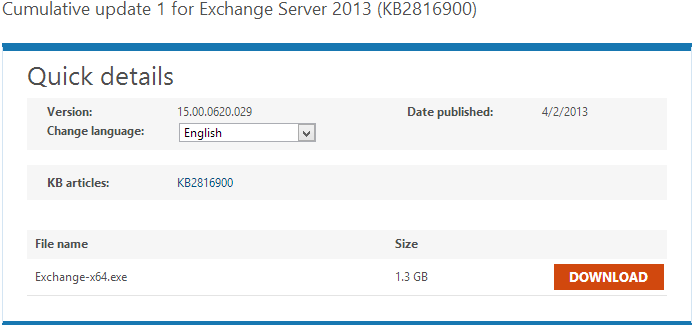Exchange 2013 Cu1 Isolation
With the Exchange 2013 Cumulative Update 1 release, companies are free to begin deploying Exchange 2013. Before doing so, however, it's important to understand important changes to the product and whether or not they will affect your migration decision.
- Exchange 2013 Cumulative Update 1 Now Available. By Kurt Mackie;; Microsoft today released Cumulative Update 1 (CU1) for Exchange 2013.
- This will be a new installation of Exchange 2013 using the CU21 media. 0) If you haven’t already done so, you first need to install the Exchange 2013 pre-requisites and prepare the AD Schema for Exchange 2013 CU21. 1) Download Exchange CU21, here is a convenience link to download the latest version of Exchange 2013.
Exchange 2013 Cu1 Isolation Form
Tags: Address Book Policy, Address Book policy Routing Agent, Exchange 2013 CU1, Microsoft Exchange, multi-tenant Exchange deployments, sender based routing agents. This entry was posted on Wednesday, February 1st, 2017 at 7:42 am and is filed under Hosting & SaaS, Microsoft Exchange.
When I first heard that Microsoft was releasing all of its Wave 15 products (Exchange 2013, SharePoint 2013, Office 2013, etc.) together, I wondered if any of the new products were being pushed out the door before they were ready. Fast forward to today, and I think it's difficult to dispute the idea that Exchange Server 2013 was released prematurely.
For example, the Exchange 2013 RTM release wasn't compatible with previous versions of Exchange Server. Sure, Exchange 2013 deployments were feasible for companies that didn't already have Exchange in place, but those that did had to wait, because Exchange 2013 RTM did not allow for coexistence.
In early April 2013, Microsoft released Cumulative Update 1 (CU1) for Exchange 2013. The update makes it possible to deploy Exchange 2013 in an existing Exchange 2007 or Exchange 2010 organization. Now that companies are free to begin their coexistence and migration journeys, it's important to understand some of the primary changes that were made and whether or not it makes sense to upgrade now or wait.
Inflated mailbox sizes

One Exchange 2013 CU1 aspect to be aware of is the fact that mailbox sizes increase after a migration. Exchange 2013 uses a different algorithm to compute mailbox sizes than previous versions of Exchange, and while Microsoft claims that the new algorithm is more accurate, the result is that mailboxes report around 30% larger than they did in Exchange Server 2010.
Now this doesn't mean that when you migrate a mailbox to Exchange 2013 it will consume 30% more storage space; the mailbox footprint doesn't actually change much. How the mailbox size is calculated is what's actually changed.
The side effect here is that after mailboxes are migrated to Exchange 2013, some users might immediately exceed their mailbox quotas as a result of the new calculations. Therefore, you should review mailbox quotas and increase as necessary before deploying Exchange 2013.

Exchange 2013 public folders
After years of telling customers that public folders would disappear, Microsoft gave in to pressure from customers. Not only does Exchange 2013 support public folders, but the feature has actually been revamped with the new modernized public folders.
Exchange 2013 Cu1 Download
Public folders were not exposed through Outlook Web App (OWA) in Exchange 2013 RTM. This was important because an increasing number of users access OWA through mobile devices that cannot run Outlook. Thankfully, Exchange 2013 CU1 includes the ability to access public folders through OWA.
Other Exchange 2013 improvements
Exchange 2013 CU1 also offers several other minor improvements. For example, the Exchange Administration Center now includes better support for unified messaging.
Exchange 2013 Cu1 Isolation Login
Exchange 2013 CU1 also includes several important bug fixes. For example, Exchange 2013 RTM included an auto-reseed option, but it didn't work if the target disk employed BitLocker encryption. Also, the Best Copy Selection algorithm that database availability groups use did not honor the MaximumActiveDatabases limit in Exchange 2013 RTM. These bugs and many others have been corrected in CU1.
Final thoughts
Microsoft uses Exchange 2013 to host millions of Office 365 mailboxes, so the product is obviously stable. That said, I'm sure that we'll see plenty more bug fixes and improvements in upcoming cumulative updates, which are scheduled to release quarterly.
Although I think it's safe to begin planning an Exchange 2013 migration, don't rush into the process. Exchange Server 2013 includes several major architectural changes over previous versions of Exchange. It's up to you to understand how these changes will impact your organization and what you'll do if something goes awry.
Exchange Server 2013 Cu1

Exchange 2013 Cu1
About the author:
Brien Posey is a ten-time Microsoft MVP with two decades of IT experience. Before becoming a freelance technical writer, Brien worked as a chief information officer at a national chain of hospitals and health care facilities. He has also served as a network administrator for some of the nation's largest insurance companies and for the Department of Defense at Fort Knox.